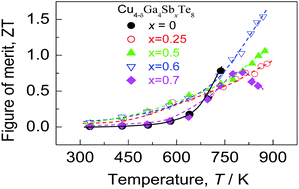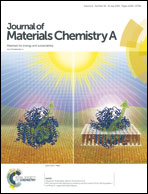Significantly improved thermal stability and thermoelectric performance of Cu-deficient Cu4−δGa4Te8 (δ = 1.12) chalcogenides through addition of Sb†
Abstract
Our previous work demonstrated that the ternary Cu18Ga25Te50 compound is a good thermoelectric candidate. However, its thermal stability is unsatisfactory, which suppresses the improvement of thermoelectric performance at high temperatures. In this work, we have tuned the chemical composition through the addition of Sb to the Cu-deficient Cu4−δGa4Te8 (δ = 1.12) compound. The first-principles calculations reveal that Sb prefers the Te site, and the replaced Te occupies the copper vacancy (TeVCu) in Cu4−δGa4SbxTe8. These occupancies enable the creation of Sb–Te bonds with higher bond dissociation energies; hence the thermal stability increases, and the lattice thermal conductivity reduces at high temperatures significantly. Besides, the defect TeVCu contributes to the formation of impurity levels within the gap, which narrows the bandgap, and also increases the density of states in the vicinity of the Fermi level (Ef). Accordingly, the Hall carrier concentration is enhanced by more than one order of magnitude compared with that in Sb-free Cu4−δGa4Te8. As a result, the highest thermoelectric (TE) figure of merit ZT at x = 0.6 reaches 1.51 at ∼870 K, which substantiates that direct addition of Sb is an effective way to improve the TE performance of Cu4−δGa4Te8 ternary chalcogenides.



 Please wait while we load your content...
Please wait while we load your content...